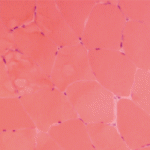“Look for drug interactions as well. Perhaps the statin wasn’t the problem at all, but the patient was on another drug that blocked the C3 or C4 pathway and raised the level of statin in the blood, causing the hyperCKemia or muscle symptoms,” said Dr. Aggarwal.
Both muscle biopsy and electromyography may help show why CK is elevated, but patients may choose to avoid these tests if their symptoms are tolerable. Some neuromuscular disorders have a benign course.
Immune-Mediated Necrotizing Myopathy
Recent findings on immune-mediated necrotizing myopathy (IMNM), an idiopathic inflammatory myopathy, include specific biomarkers, said Eleni Tiniakou, MD, an instructor of medicine at Johns Hopkins School of Medicine in Baltimore. Distinct from dermatomyositis or polymyositis, IMNM is “a third pattern we see in muscle biopsies: necrotizing myopathy, where we see prominent myofiber necrosis, degeneration and regeneration, and sparse inflammation,” she said. Two myositis-specific autoantibodies, anti-SRP and anti-HMCGR, play a role in IMNM.3
IMNM patients may have subacute or insidious disease onset, symmetrical proximal muscle weakness, elevated CK, and at least one of the following clinical features: irritable myopathy, edema on MRI or a myositis-specific autoantibody. Muscle biopsy confirms diagnosis.4
Women with IMNM often have the anti-SRP form, which has severe, rapid progression. Patients have highly elevated CK, minimal extramuscular manifestations, such as Raynaud’s phenomenon or interstitial lung disease (ILD), and may have dysphagia or cardiac involvement. Childhood- or early adulthood-onset predicts worse outcomes for those with anti-SRP IMNM, and patients may be very resistant to treatment, she said.
Patients with anti-HMCGR IMNM are female in up to 73% of cases, have severe muscle weakness, highly elevated CK, minimal extramuscular manifestations and may have dysphagia, but statin exposure is the most common culprit. Percentages of anti-HMCGR IMNM patients who have used statins are far lower in Asian studies than those conducted in the West. Patients in Asian cohorts tend to be younger overall, but they may also be exposed to statins in foods rather than prescription medication, said Dr. Tiniakou.
Statins were first described in fungi, and “mushrooms are a very common ingredient in Chinese and Japanese cuisine. Red yeast rice, a traditional Chinese medicinal product, contains high levels of statins, as does pu-erh tea, which is manufactured in China and has become popular for its cholesterol-lowering properties.” Younger age at diagnosis also tends to worsen anti-HMCGR IMNM outcomes, and this myopathy is also treatment resistant.
Immunoprecipitation is used to detect both autoantibodies in IMNM patients. Commercial ELISA tests are also available, but these are costly and may result in false positives, she said. Use ELISA tests only in patients with CK levels over 1,000 for more than eight weeks, or those who have persistent muscle weakness, she said.5 Combination therapy is the best approach for IMNM, usually prednisone and either azathioprine, mycophenolate mofetil or methotrexate.
Lung Disease in Myositis
Lung disease is treatable in some myositis patients, but may be life threatening in others, said Paul F. Dellaripa, MD, associate professor of medicine at Harvard Medical School and a rheumatologist at Brigham and Women’s Hospital in Boston.

